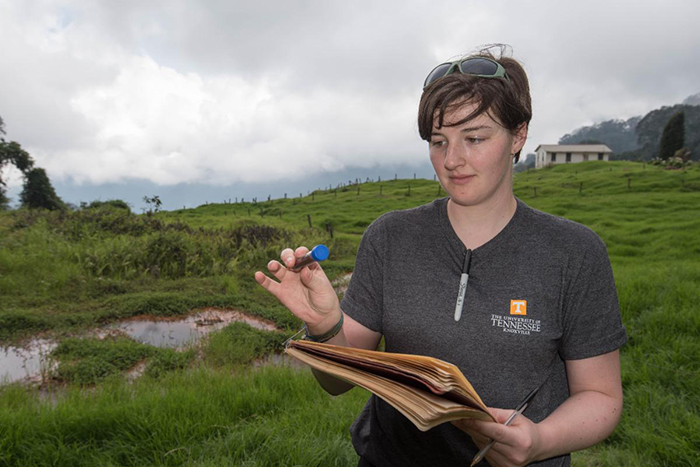| |
Pellissippi State employee’s research shows microbes reduce natural carbon emissions
May 10, 2021
KNOXVILLE - When people talk about ways to reduce greenhouse gas emissions, many suggest driving their cars less or planting a tree. But there may be an important group of organisms too tiny to see with the naked eye that are also making an impact.

Kate Fullerton‘s research on bacteria found in hot springs in Costa Rica showed microbes were consuming between 2 and 22% of the carbon released from these hot springs. Photo courtesy of Katie Pratt and the Deep Carbon Observatory |
Bacteria found in hot springs in Costa Rica are helping reduce the amount of global warming-causing carbon dioxide released into the atmosphere, according to research by Pellissippi State Community College Instructional Systems Specialist Kate Fullerton.
Fullerton’s thesis work was published April 22 in Nature Geoscience, a monthly journal about Earth sciences research, and featured in an April 22 story in Science magazine.
The publication comes almost two years after Fullerton earned her master’s degree in microbiology from the University of Tennessee and started her job with Pellissippi State as a lab technician on the College’s Strawberry Plains Campus.
“I knew I enjoyed microbes and what they do in the environment,” said Fullerton, who earned her bachelor’s degree in biotechnology from Rutgers University in her native New Jersey. “And carbon cycling is really interesting and dynamic because carbon comes in a lot of different forms.”
Costa Rica was a perfect spot for researching the relationship between microbes and carbon dioxide because the country is in a subduction zone, where tectonic plates floating on Earth’s molten center clash and one slips beneath the other.
“That process basically recycles the sediment, rock and organic material on that plate, removing carbon from the (Earth’s) surface, which is a good thing,” Fullerton explained. “Some of that carbon is recycled back into the Earth’s core, but some of it comes out of volcanoes during eruptions. And some of it bubbles up naturally in these hot springs around the volcanoes.”
As part of UT Associate Professor Karen Lloyd's lab for Deep Subsurface biosphere research, Fullerton completed two two-week field exhibitions to Costa Rica and Panama. The data published April 22 covers 24 hot springs Fullerton visited in Northern Costa Rica during 2017.
“Our first goal was to try to determine how the microbial diversity varies on a regional scale because past research tended to focus on a single location at a time,” Fullerton said. “Second: is there evidence that microbes in these hot springs are affecting the greenhouse gases coming out of them?”
Fullerton and a team of fellow researchers from several international institutions already knew that bacteria can eat greenhouse gases, but they set out to discover whether they could experimentally show that microbes in these hot springs are eating these gases and therefore reducing the amount of carbon dioxide released back into the atmosphere.
“We needed to isolate (and concentrate) the bacteria from the water, so we attached filters to large syringes that would collect the bacteria,” Fullerton explained. “We would repeat this process until we had filtered a total of 2 liters of water at each sample site, which could take anywhere from 10-15 minutes to an hour, depending on how clogged the filter was getting with particles.”
Then it was back to the lab for “bench work,” which included extracting DNA from the microbe-filled filters, then sequencing it to identify “who” was there. Fullerton also counted the number of microbial cells in each sample using flow cytometry and a small laser.
Using Fullerton’s data and geochemical data collected by her colleagues, the team built a computer model that predicted that the microbes were consuming between 2 and 22% of the carbon released from these hot springs.
“I know that’s a large range, and a lot of work still needs to be done, but this is the first time someone has tried to quantify the effect of the microbes on such a large scale,” she said.
At 27 years old, Fullerton still has plenty of time to build on her research, should she want to one day follow that path. In the meantime, she’s “fallen in love with Tennessee” and is enjoying her work at Pellissippi State, where she transitioned to a support role with Educational Technology Services in November 2020.
“I love learning, and I have taken several classes at Pellissippi State,” Fullerton said. “I am hoping to pick up some adjuncting as well because I discovered early on in graduate school that I love teaching."
You can read Fullerton’s work on microbes in its entirety in Nature Geoscience or a story that explains the science in more layman’s terms in Science.
|

